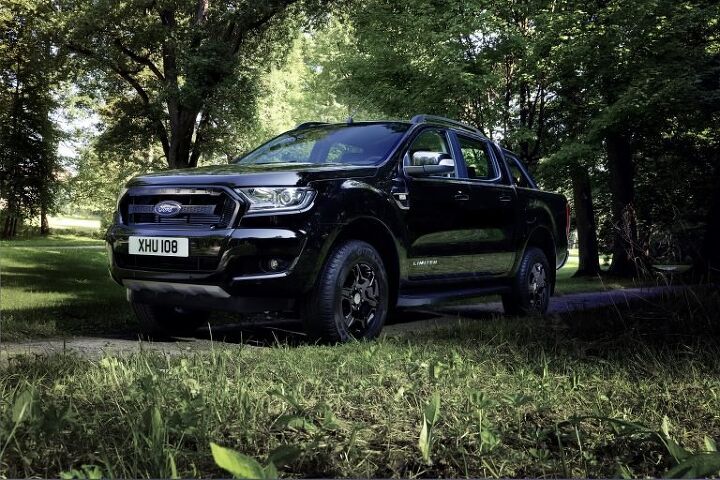Europeans Slowly Fall Victim to Pickup Truck Fever

Don’t worry, they aren’t suffering. As shown by the rise of pickup trucks as daily drivers and family haulers in North America, Europe’s burgeoning love affair with versatile light trucks isn’t hurting the owners. It’s traditional passengers car makers who must worry.
Sales stats arriving from the Continent show a marketplace that’s increasingly different from years gone by. The increasing popularity of SUVs and crossovers in the land of diesels, manual transmissions, and small displacements is nothing new, but the exploding popularity of honest-to-God pickups is.
According to JATO Dynamics data published by Automotive News Europe, midsize pickup sales in Europe rose 19 percent in the first half of 2017. While that only amounts to 80,300 pickups sold, a fraction of the 216,194 sold in the U.S. in Q1 2017, the segment’s just getting started. Some analysts expect volume to top 200,000 units next year.
What’s fueling the hunger for a vehicle type long associated with public works crews, laborers and nothing else? Choice, for one thing, but also — to some degree — government regulations.
With fuel economy and emissions standards growing ever stricter, the traditional body-on-frame SUVs used by the well-heeled to pull trailers and boats are dwindling from the marketplace. Crossovers, especially those with small-displacement turbocharged engines and multi-cog transmissions, can’t cut it. Enter the body-on-frame midsize truck and its often hefty towing capacity.
In the UK, by far the biggest truck-buying country in Europe, the demise of the revered Land Rover Defender made consumers take a second look at the Ford Ranger for such duties. Pickup sales rose 17 percent in the UK in the first half of 2017. In Germany, it was 15 percent. France saw pickup sales rise 20 percent, while sales in Sweden and Italy rose 24 and 20 percent, respectively.
So promising is the fledgling segment, automakers are scrambling to field European-market pickups. Volkswagen already sells its Amarok, while Nissan’s Navara, Mitsubishi’s L200/Triton, Fiat’s Fullback, Ford’s Ranger, and Toyota’s Hilux round out the available offerings. Catering to buyers in the luxury market, Mercedes-Benz’s X-Class appears this year.
Renault — hardly a name you associate with rugged, do-anything private vehicles — is now considering whether it should sell its overseas-market Alaskan pickup (based, like the X-Class, on the Navara) in Europe. Meanwhile, PSA Group, maker of Citroën and Peugeot cars, wonders whether it should enter the fray or risk being left behind. The French automaker announced a joint venture with China’s Changan Automobile in September for a midsize, Chinese-market pickup. Maybe Europeans would like it, too.
With the exception of the Ranger, which comes to America in 2019, there’s little Detroit presence in the European truck field. If you’ve got the cash to spend, importers like AEC Europe will get you behind the wheel of a Ram 1500, which is exactly what one French man did.
In a recent interview with Trucks.com, Philippe Leroy describes his purchase of a gas-guzzling, lane-hogging 1500 back in 2009. The French cards were stacked against the obese American vehicle, but he soon grew to love it. He’s bought a new one from a Paris importer every two years since.
“At first, they don’t understand why I’m driving such a car,” Leroy said of the naysayers. “But when I talk about the benefits for buying this car, they understand. It’s the perfect truck for everyday living.”
[Images: Ford Europe, Renault]

More by Steph Willems
Latest Car Reviews
Read moreLatest Product Reviews
Read moreRecent Comments
- Corey Lewis It's not competitive against others in the class, as my review discussed. https://www.thetruthaboutcars.com/cars/chevrolet/rental-review-the-2023-chevrolet-malibu-last-domestic-midsize-standing-44502760
- Turbo Is Black Magic My wife had one of these back in 06, did a ton of work to it… supercharger, full exhaust, full suspension.. it was a blast to drive even though it was still hilariously slow. Great for drive in nights, open the hatch fold the seats flat and just relax.Also this thing is a great example of how far we have come in crash safety even since just 2005… go look at these old crash tests now and I cringe at what a modern electric tank would do to this thing.
- MaintenanceCosts Whenever the topic of the xB comes up…Me: "The style is fun. The combination of the box shape and the aggressive detailing is very JDM."Wife: "Those are ghetto."Me: "They're smaller than a Corolla outside and have the space of a RAV4 inside."Wife: "Those are ghetto."Me: "They're kind of fun to drive with a stick."Wife: "Those are ghetto."It's one of a few cars (including its fellow box, the Ford Flex) on which we will just never see eye to eye.
- Oberkanone The alternative is a more expensive SUV. Yes, it will be missed.
- Ajla I did like this one.



































Comments
Join the conversation
For France at least, pick-up love doesn't have much to do with their intrinsic qualities. It is simply a regulatory effect. If you want your large family hauler to have an enclosed trunk, it would come with a 1'000 to frequently 10'000 euros tax. If you accept the small drawback of the current crop of pick-ups, this tax doesn't exist cause it's a "utility vehicle". It's basically a loophole just as the CAFE one regarding light trucks, but directly affecting clients.
In Australia, the pickup truck fever started about 10 years ago...now dual cab versions (HiLux and Ranger in particular, among many other competitors) are literally everywhere. It has now become a lot harder to see Single Cabs as a result nowadays (most seem to be bought by fleets).